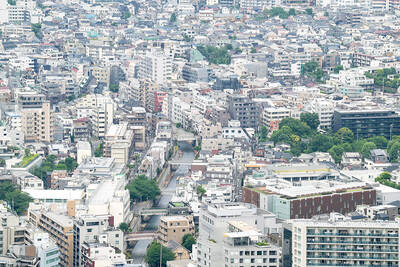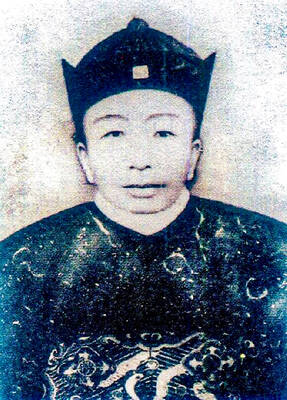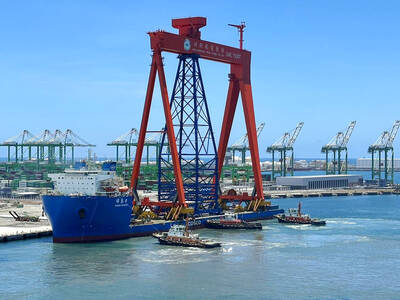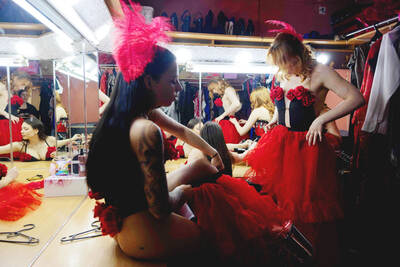Until he was 38 years old, Max Liu (劉其偉) had no inkling of his talents. When the then electrical engineer went to an exhibition of paintings by Hsiang Hong (香洪), who was also an engineer, he became
convinced that he could paint, too. Two years later, the autodidact held his first solo exhibition in Taipei's Chungshan Hall. Until his death at age 92 last month, Liu remained the "Picasso of Taiwan" in the eyes of art critics here for his semi-abstract watercolors celebrating the primitive and the wild.
Explorer of Art: A Memorial Exhibition of Max Liu, the current exhibition at the National Museum of History, shows 120 works spanning four decades of Liu's creative career. The works in the comprehensive exhibition are divided into eight themes -- one of which consists only of Liu's unfinished last painting. On the last day of his life, Liu was still working on the untitled abstract and about to tear it up out of dissatisfaction when his heart failed.
"Originally we planned this to be a thematic exhibition. Now it has to be a memorial one, much to our regret," said museum head Huang Kuang-nan (黃光男), at the press conference for the event. "Liu transcended life," said Chen Huei-mei (鄭惠美), author of Max Liu: An Explorer and Wizard and curator of the exhibition.
"Many of us spend our lives on just one enterprise. Liu pursued various aspects of life: adventure, art, anthropology, environmental protection and so on. He
challenged life to the utmost."
Although painting led to an unexpectedly colorful life for Liu, he originally intended it as an emotional outlet. "The first half of my life was full of discontent and frequent frustration. ... Painting was a way for me to save myself from pessimism and ... to dissipate my bad mood," Liu was
once quoted as saying about his impoverished and wandering childhood and dull adult life as a government worker.
Liu's idea of painting as a diversion from life's boredom turned into serious endeavor in 1965, when he went to Vietnam to work as an engineer for the US military during the Vietnam war. Hard work in daytime did not prevent the energetic painter from painting at night or going to sketch in neighboring countries whenever he was free.
The Peninsula -- Epic (半島-史詩) section shows Liu's works from this prolific period. The semi-abstract watercolors portray religious ceremonies and Hindu deities in dreamy colors.
An artist in the thick of war, Liu seemed to concern imself not with the intricacies of warfare but the mystery of religion and the influence of traditions and heritage on everyday life. Works like Peaceful and Fruitful
Year (太平年) and Ritual of Fire (火的儀式) capture the artistic traditions left by the ancient empires of Angkor, Siam and Cham. The lasting influence of these cultures on Liu made the two years in Indochina a turning
point in his career.
Shortly after returning to Taiwan at 58, Liu quit his government job to teach in college. Regarded by his students as an unassuming professor with a crude sense of humor, Liu remained an enthusiastic teacher all his life.
It was also soon after his life in Vietnam that Liu actively began participating in field trips studying the cultures of minorities and indigenous people. His strong interest in ancient civilizations took him to
South Korea, the Philippines, the remains of the Maya and Inca civilizations in Latin America and Taiwan's Aboriginal communities.
"Modern art is often inspired by primitive art. To understand the essence of art, one cannot but explore primitive art," Liu was once quoted as saying.
After these trips came the maturing of Liu's style, exemplified by his most celebrated work -- Evening Call (薄暮的呼聲), painted in 1979. Fascinated by the subject, Liu made nearly two dozen paintings of an oval-shaped red-and-black bird against the setting sun throughout his life. All of them are titled Evening Call but it was the 1979 version that made observers
notice the maturity.
Unfortunately, the exhibition shows only one of them, in the Life -- Philosophy (生命-哲思) section. Inspired by Paul Klee's small-format works in the 1940s, the painting blends the realistic and the abstract with color
blocks to present the bird.
Behind the painting is the story of Po Yo Bird (婆憂鳥), which Liu's grandma told him in his childhood. As the story goes, there was a very poor family with a boy and a loving grandma. On a festival day, the boy wanted a
rice tamale, which the grandma couldn't afford. She then made one with earth to stop him from crying. However, mistaking for real, the boy swallowed the earth tamale and died. Afterwards, the grandma cried day in and day out at
the loss of her beloved grandson. To comfort her, the boy transformed into a bird flitting at her door chirping poyo, poyo, meaning "grandma, don't feel sad for me."
The section features many of Liu's best works, evolved from his belief that there's a spirit in everything. Liu painted a rock as a lovely high-spirited round-faced girl in Goblin in the Keelung Mountain (基隆山的小精靈).
Wagon in Manila (馬尼拉的馬車) illustrates his activism for animal protection. The painting originally came with the text: "If you have been to Manila, did you carefully observe the cart horses? Did you see how their
hoofs slip on the cobble stones or how they drag cart wheels out of one crack on the road before soon sinking into another?"
Love for wildlife drove Liu to many trips to preservation areas including rainforests in Borneo, South Africa, Kenya and Papua New Guinea. The 1984 series of African wildlife in The Wild -- The Calling (野性-呼喚) section shows a different side to Liu's sometimes sweet sentimentality in
his other works. Paintings like Leopard Hunting (獵豹) and Animal Emperor (萬獸之王) reveal Liu's deep personal involvement and sympathy for wildlife.
Another highlight of the exhibition is Liu's 16 self-portraits, mostly painted when he was over 80. The Character -- Crossover (角色-越界) section is where viewers may find the most interesting works in the
exhibition. Out of light-hearted self-ridicule, Liu painted himself as a clown, an owl, a cowboy or even a blackboard. In Those days of Frustration -- Self Portrait (那段潦倒的日子), Liu appears like a frog smashed flat on
a window pane, but something in his black and white face suggests a happy-go-lucky spirit and a resilient vitality.

The canonical shot of an East Asian city is a night skyline studded with towering apartment and office buildings, bright with neon and plastic signage, a landscape of energy and modernity. Another classic image is the same city seen from above, in which identical apartment towers march across the city, spilling out over nearby geography, like stylized soldiers colonizing new territory in a board game. Densely populated dynamic conurbations of money, technological innovation and convenience, it is hard to see the cities of East Asia as what they truly are: necropolises. Why is this? The East Asian development model, with

June 16 to June 22 The following flyer appeared on the streets of Hsinchu on June 12, 1895: “Taipei has already fallen to the Japanese barbarians, who have brought great misery to our land and people. We heard that the Japanese occupiers will tax our gardens, our houses, our bodies, and even our chickens, dogs, cows and pigs. They wear their hair wild, carve their teeth, tattoo their foreheads, wear strange clothes and speak a strange language. How can we be ruled by such people?” Posted by civilian militia leader Wu Tang-hsing (吳湯興), it was a call to arms to retake

This is a deeply unsettling period in Taiwan. Uncertainties are everywhere while everyone waits for a small army of other shoes to drop on nearly every front. During challenging times, interesting political changes can happen, yet all three major political parties are beset with scandals, strife and self-inflicted wounds. As the ruling party, the Democratic Progressive Party (DPP) is held accountable for not only the challenges to the party, but also the nation. Taiwan is geopolitically and economically under threat. Domestically, the administration is under siege by the opposition-controlled legislature and growing discontent with what opponents characterize as arrogant, autocratic

When Lisa, 20, laces into her ultra-high heels for her shift at a strip club in Ukraine’s Kharkiv, she knows that aside from dancing, she will have to comfort traumatized soldiers. Since Russia’s 2022 invasion, exhausted troops are the main clientele of the Flash Dancers club in the center of the northeastern city, just 20 kilometers from Russian forces. For some customers, it provides an “escape” from the war, said Valerya Zavatska — a 25-year-old law graduate who runs the club with her mother, an ex-dancer. But many are not there just for the show. They “want to talk about what hurts,” she